
Melaleuca radula, commonly known as graceful honey-myrtle, is a plant in the myrtle family, Myrtaceae and is endemic to the south-west of Western Australia. It is an open, spreading shrub with narrow leaves, profuse pink or purple flowers in late winter and smooth, almost spherical fruits.
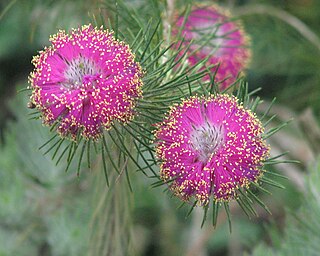
Melaleuca trichophylla is a shrub in the myrtle family, Myrtaceae, endemic to the south-west of Western Australia. Its pink or purple flowers appear from August to December in its native range. It has long been cultivated.

Melaleuca viminea, commonly known as mohan is a plant in the myrtle family Myrtaceae and is endemic to the south-west of Western Australia. It is variable in size and form from a densely branched, small shrub to a small tree. It has become naturalised locally in southern Victoria.
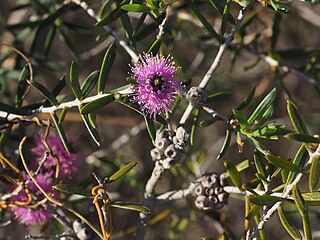
Melaleuca caeca is a plant in the myrtle family, Myrtaceae and is endemic to the south-west of Western Australia. It is similar to a number of other Western Australian melaleucas such as M. pentagona with its purple pom-pom flower heads but it is a smaller shrub with narrower leaves and smaller inflorescences.
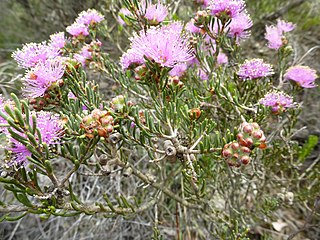
Melaleuca carrii is a plant in the myrtle family, Myrtaceae and is endemic to the south-west of Western Australia. It is a small shrub similar to Melaleuca pentagona, with "pom-pom" heads of pinkish flowers and sharply pointed leaves but it is generally smaller, lacks a groove in its leaves and retains its petals on the flowers for longer than that species.
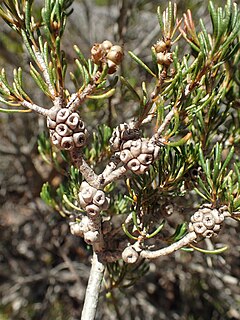
Melaleuca clavifolia is a plant in the myrtle family, Myrtaceae and is endemic to the south-west of Western Australia. It is a small shrub similar to Melaleuca tinkeri, with "pom-pom" heads of pinkish flowers and soft, silky hairs on the new growth but it has larger flower heads and its leaves are shorter, more club-shaped and have less distinct oil glands.
Melaleuca keigheryi is a shrub in the myrtle family, Myrtaceae with white, papery bark and is endemic to the west coast of Western Australia. In spring, it has heads of pink flowers which fade in color to become white.

Melaleuca leuropoma is a plant in the myrtle family, Myrtaceae and is endemic to the south-west of Western Australia. It is a small to medium-sized shrub which flowers over an extended period with flower colour varying from purple to yellow or white. The glossy, often brown petals covering the flower buds are also an unusual characteristic of this species.
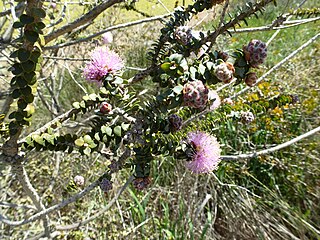
Melaleuca orbicularis is a plant in the myrtle family, Myrtaceae and is endemic to the south-west of Western Australia. It is similar to Melaleuca cordata with its pinkish "pom-pom" heads of flowers but its leaves are smaller, almost circular compared to the heart shaped leaves of the other species.

Melaleuca ryeae is a plant in the myrtle family, Myrtaceae and is endemic to the south west of Western Australia. It is a small shrub, closely resembling Melaleuca amydra with its small leaves and profuse heads of pink to purple flowers but M.amydra has narrower leaves and does not have spherical clusters of fruits.

Conothamnus is a genus of flowering plants in the family Myrtaceae and is endemic to the south-west of Western Australia. They are woody shrubs similar to melaleucas but differ in that their leaves are usually arranged in opposite pairs and the maximum number of seeds per fruit is three.

Eremaea fimbriata is a plant in the myrtle family, Myrtaceae and is endemic to the south-west of Western Australia. It is a small shrub with small leaves and single purple flowers on the ends of the branches. The fruits are woody, urn-shaped with a small opening at the top. Unlike other eremaeas which remain dormant during winter, Eremaea fimbriata begins the new year's growth in July or August.

Melaleuca filifolia, commonly called wiry honey-myrtle, is a plant in the myrtle family Myrtaceae, and is endemic to the south-west of Western Australia. It is a woody, twiggy shrub with needle-shaped leaves, greenish flower buds, pink "pom-pom" flower heads and spherical clusters of fruits.
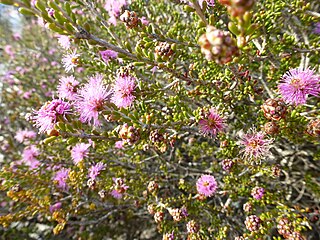
Melaleuca rigidifolia is a shrub in the myrtle family Myrtaceae, endemic to the south of Western Australia. It is similar to Melaleuca plumea with its pink or purple flowers but is distinguished from that species by its lack of fluffy hairs on the flowers and its spherical clusters of fruits.

Melaleuca scabra, commonly known as rough honey-myrtle, is a species of shrub that is endemic to a small area on the south coast of Western Australia. It has warty leaves and profuse, pink to purple heads of flowers between July and November.

Melaleuca seriata is a shrub in the myrtle family, Myrtaceae, and is endemic to the south-west of Western Australia. In describing it, John Lindley wrote "Melaleuca seriata, parviceps, and trichophylla, are bushes, every twig of which is terminated by hemispherical heads of a brilliant pink." It is very similar to Melaleuca parviceps.

Melaleuca subtrigona is a plant in the myrtle family, Myrtaceae, and is endemic to the south-west of Western Australia. It is a small shrub with warty leaves and heads of "pom-pom" flowers in spring and early summer.
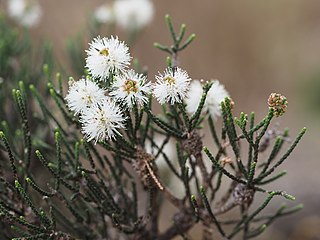
Melaleuca thyoides, commonly known as salt lake honey-myrtle is a plant in the myrtle family, Myrtaceae and is endemic to the south-west of Western Australia. It is an erect shrub with grey, papery or fibrous bark and very small, overlapping leaves on thin branchlets. It is a salt tolerant species often found on the edges of salt lakes.

Beaufortia macrostemon, commonly known as Darling Range beaufortia, is a plant in the myrtle family, Myrtaceae and is endemic to the south-west of Western Australia. It is a low shrub with multiple stems, hairy young leaves and three stamens in each stamen bundle.

Beaufortia purpurea, commonly known as purple beaufortia, is a plant in the myrtle family, Myrtaceae and is endemic to the south-west of Western Australia. It is an erect or spreading shrub with linear to egg-shaped leaves and purplish-red flowers in dense heads on the ends of branches which continue to grow after flowering.





















